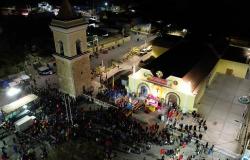In 1963, Peter Hujar (New Jersey, 1934-New York, 1987) and the sculptor and painter Paul Thek traveled together to Sicily. They maintained an intense and productive relationship; that trip would leave a deep mark on their sensibilities. Specifically, their visit to the Catacombs of the Capuchins, in Palermo, where they walked among the glass coffins and the eight thousand embalmed corpses—“not skeletons, but corpses,” as Thek would describe—that were piled up in the hallways. . That brief walk through the kingdom of the dead would inspire the best-known sculptural pieces of the plastic artist, Technological Reliquariesas well as the only book published during the legendary photographer’s lifetime: Portraits in Life and Death (1976), today converted into a cult book. The photographic series is shown for the first time in Europe, in an exhibition held to coincide with the Venice Biennale, at the Istituto Santa Maria della Pietà.
“We no longer study the art of dying, a common and hygienic discipline in the oldest cultures; but all eyes, at rest, contain that knowledge. The body knows it. And the camera shows it, inexorably,” wrote Susan Sontag in the book’s prologue. A text that the author would write after being diagnosed with breast cancer. In the sanatorium room, waiting for an intervention, she asked her friend Stephen Koch for paper and a pen. The author had completely forgotten Hujar’s assignment. “In one hour she wrote the entire essay,” as her friend, the novelist, recalled.
Hujar and Sontag met in 1963. However, it would take the elusive photographer three years to show the author his work of the catacombs; that disturbing funeral ode would impress the author so much that she would use that same landscape in the last scene of her second novel. , death case (1967). Eleven of the photographs became part of the photographer’s book, accompanied by a series of 29 portraits of somber beauty taken between 1974 and 1975, where Sontag herself appears, along with Divine, Robert Wilson, William Borroughs, Fran Lebowitz, John Waters and other more unknown protagonists of the diverse demimonde from the Lower East Side of Manhattan.
The imposter was never with Hujar, hence, regardless of any artifice or idealization, his silent portraits reached an unusual psychological depth. His protagonists mostly appear in a state of rest. Many adopt the same pose. Some close their eyes, while in the gaze of others both the brilliance and the fragility of their existence will be reflected; the inevitability of death. “Photography turns the whole world into a cemetery. Photographers, connoisseurs of beauty, are also—consciously or unconsciously—the recording angels of death,” wrote Sontag.
Confronting life with death, with the same forcefulness as delicacy, Hujar alluded to the paradoxical relationship of photography with both immortality and death. To the capacity of the medium to offer evidence of existence, as well as to transfer reality to a past time. When we look at a photograph, we are observing a moment that has already passed, it is therefore the confirmation of an absence. A destiny that ironically would seem to recall the photograph that the author chose as the cover, Palermo Catacombs #1, where a masked corpse appears to mock the living. “Peter Hujar knows that portraits in life are always portraits in death as well,” Sontag warned.
The author never consciously intended to reflect a time, his models were such simply because they were his friends or caught his attention. He would exquisitely print all the copies in the darkroom of his Second Avenue apartment. “Death is going to be very fashionable this season,” he joked before the publication of the monograph. He didn’t get it right, he got only four reviews, the best ones were published in TheVillageVoice. However, his warning today sounds like a premonition of what was to come. Some of her models would face death early: Candy Darling died at just 29 years old, in 1973, a victim of lymphoma; She portrayed Jackie Curtis on her deathbed (neither of those two portraits are included in the exhibition); The dancer James Waring died at fifty, after receiving the photographer’s care. Hujar himself was diagnosed with AIDS on January 1, 1987. He never picked up the camera again. He died on Thanksgiving Day of that same year, but not before asking his friend David Wojnarowicz (he also died of AIDS in 1993) to photograph him dead. A circle that he had started in Palermo was closed, where life and death walked together.
Portraits in Life and Death. Peter Hujar. Istituto Santa Maria della Pietà. Venice. Until November 24.
You can follow Babelia in Facebook and xor sign up here to receive our weekly newsletter.



